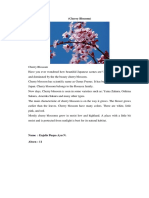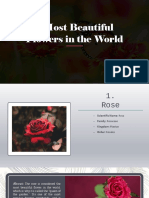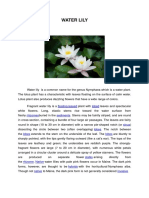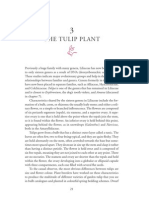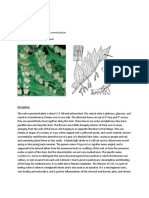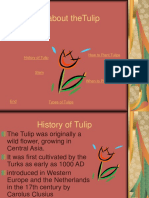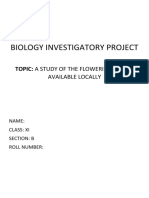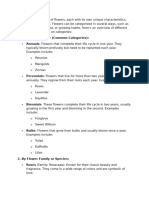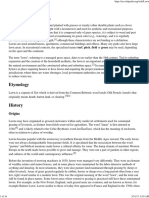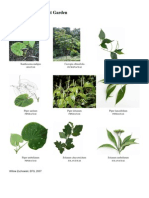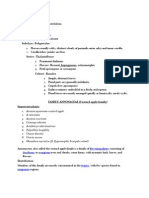Tulips
Tulips
Uploaded by
glh00Copyright:
Available Formats
Tulips
Tulips
Uploaded by
glh00Original Description:
Copyright
Available Formats
Share this document
Did you find this document useful?
Is this content inappropriate?
Copyright:
Available Formats
Tulips
Tulips
Uploaded by
glh00Copyright:
Available Formats
Tulip - Wikipedia, the free encyclopedia
1 of 12
https://en.wikipedia.org/wiki/Tulip
Tulip
From Wikipedia, the free encyclopedia
The tulip is a Eurasian and North African genus of perennial, bulbous plants in the lily family.[1] It is an
herbaceous herb with showy flowers, of which around 75 wild species are currently accepted.[2]
The genus's native range extends west to the Iberian Peninsula, through North Africa to Greece, the Balkans,
Turkey, throughout the Levant (Syria, Israel, Palestinian Territories, Lebanon, Jordan) and Iran, north to
Ukraine, southern Siberia and Mongolia, and east to the Northwest of China.[1][2] The tulip's centre of diversity
is in the Pamir, Hindu Kush, and Tien Shan mountains.[3] It is a common element of steppe and winter-rain
Mediterranean vegetation.
A number of species and many hybrid cultivars are grown in gardens or as potted plants.
Description
Tulips are spring-blooming perennials that grow from bulbs. Depending on the species, tulip plants can be
between 4 inches (10 cm) and 28 inches (71 cm) high. The tulip's large flowers usually bloom on scapes with
leaves in a rosette at ground level and a single flowering stalk arising from amongst the leaves.Tulip stems have
few leaves. Larger species tend to have multiple leaves. Plants typically have two to six leaves, some species up
to 12. The tulip's leaf is strap-shaped, with a waxy coating, and the leaves are alternately arranged on the stem;
these fleshy blades are often bluish green in color. Most tulips produce only one flower per stem, but a few
species bear multiple flowers on their scapes (e.g. Tulipa turkestanica). The generally cup or star-shaped tulip
flower has three petals and three sepals, which are often termed tepals because they are nearly identical. These
six tepals are often marked on the interior surface near the bases with darker colorings. Tulip flowers come in a
wide variety of colors, except pure blue (several tulips with "blue" in the name have a faint violet hue).[4][5]
The flowers have six distinct, basifixed stamens with filaments shorter than the tepals. Each stigma has three
distinct lobes, and the ovaries are superior, with three chambers. The tulip's seed is a capsule with a leathery
covering and an ellipsoid to globe shape. Each capsule contains numerous flat, disc-shaped seeds in two rows
per chamber.[6] These light to dark brown seeds have very thin seed coats and endosperm that does not normally
fill the entire seed.[7]
Phytochemistry
Tulipanin is an anthocyanin found in tulips. It is the 3-rutinoside of delphinidin. The chemical compounds
named tuliposides and tulipalins can also be found in tulips and are responsible for allergies.[8] Tulipalin A, or
-methylene--butyrolactone, is a common allergen, generated by hydrolysis of the glucoside tuliposide A. It
induces a dermatitis that is mostly occupational and affects tulip bulb sorters and florists who cut the stems and
leaves.[9] Tulipanin A and B are toxic to horses, cats and dogs.[10]
Taxonomy
The genus Tulipa was traditionally divided into two sections, Eriostemones and Tulipa (as Leiostemones),[11]
and comprises ca. 76 species.[2]
4/9/2016 7:57 PM
You might also like
- Alicia Lee Homeopathic Mind Maps - Remedies of The Plant KingdomDocument6 pagesAlicia Lee Homeopathic Mind Maps - Remedies of The Plant KingdomAmritaNo ratings yet
- Tulip Reading APTIS SVDocument5 pagesTulip Reading APTIS SVNguyen Vy100% (1)
- Tulip-reading-APTIS-SVDocument5 pagesTulip-reading-APTIS-SVNgọc VyNo ratings yet
- Inside Greenhouses For Cultivation of Tulip Flowers: ISSN (PRINT) :2394-6202, (ONLINE) :2394-6210, VOLUME-1, ISSUE-6,2015Document11 pagesInside Greenhouses For Cultivation of Tulip Flowers: ISSN (PRINT) :2394-6202, (ONLINE) :2394-6210, VOLUME-1, ISSUE-6,2015Omar Obaid100% (1)
- FlowersDocument6 pagesFlowersAdia IndahNo ratings yet
- Sexual ReproductionDocument6 pagesSexual ReproductionAlyssa Margareth SorianoNo ratings yet
- 3 Endangered Plant SpeciesDocument7 pages3 Endangered Plant SpeciesBharat SinghNo ratings yet
- Contoh Text ReportDocument6 pagesContoh Text ReportIrfan Nax StmNo ratings yet
- Flowers, Flowers and More Flowers and Some Trees: by Lachlan KelaartDocument12 pagesFlowers, Flowers and More Flowers and Some Trees: by Lachlan KelaartRena WalshNo ratings yet
- Species Tulips - DengardenDocument5 pagesSpecies Tulips - Dengardenclaws_wielderNo ratings yet
- Report TextDocument10 pagesReport Textduz thaNo ratings yet
- Tulip FlowerDocument4 pagesTulip FlowerEpi Trisna MaulaniNo ratings yet
- Tugas English Kelompok 5 (9b) - 20240727 - 163453 - 0000Document8 pagesTugas English Kelompok 5 (9b) - 20240727 - 163453 - 0000tersidilor15No ratings yet
- Tulipe: Sofi Nirmala 15620011 Anis Safitri 15620028 M. Nabil A.M 15620062Document8 pagesTulipe: Sofi Nirmala 15620011 Anis Safitri 15620028 M. Nabil A.M 15620062Muhammad Nabil Al MuntazhorNo ratings yet
- Pharmacognosy Presentation UmbelliferaeDocument28 pagesPharmacognosy Presentation Umbelliferaeanita dahalNo ratings yet
- Tulips Are spri-WPS OfficeDocument1 pageTulips Are spri-WPS OfficeIan Rex DesolocNo ratings yet
- 7 Most Beautiful Flowers in The WorldDocument15 pages7 Most Beautiful Flowers in The WorldWai Lana Butler100% (1)
- Water LilyDocument10 pagesWater LilyTri Cahyo Purnomo0% (1)
- Tulips (Tulipa) Form A: Amana Erythronium GageaDocument1 pageTulips (Tulipa) Form A: Amana Erythronium GageaThareendranRavindranNo ratings yet
- The Tulip PlantDocument12 pagesThe Tulip PlantTimber PressNo ratings yet
- Bio 206 Seed PlantsDocument58 pagesBio 206 Seed Plantsolorunsolaolamide3No ratings yet
- Biol 366 Asterids 3 TextDocument36 pagesBiol 366 Asterids 3 TextTimothy JohnsonNo ratings yet
- Biology Investigatory ProjectDocument19 pagesBiology Investigatory ProjectCharanjiithramanan Karthikeyan42% (12)
- Contoh Report TextDocument3 pagesContoh Report TextShana100% (2)
- English ProjectDocument9 pagesEnglish ProjectSajal KumarNo ratings yet
- 1111111Document48 pages1111111Jaipal Sheoran100% (2)
- TurmericDocument2 pagesTurmericnick7simichNo ratings yet
- Commelina Communis, Commonly Known As The AsiaticDocument10 pagesCommelina Communis, Commonly Known As The AsiaticCyrus Yu Shing ChanNo ratings yet
- Chelsea ArcherDocument2 pagesChelsea Archerapi-24572051No ratings yet
- Tulip 2Document20 pagesTulip 2Adhish khadkaNo ratings yet
- PollinationDocument19 pagesPollinationPrabhu MishraNo ratings yet
- Lilium Ledebourii "Susan - e Chelcheragh"Document14 pagesLilium Ledebourii "Susan - e Chelcheragh"Elham PeiroviNo ratings yet
- Rafflesian Dan Kembang SepatuDocument2 pagesRafflesian Dan Kembang SepatuYukimura SanadaNo ratings yet
- All About Thetulip: History of Tulip How To Plant TulipsDocument5 pagesAll About Thetulip: History of Tulip How To Plant TulipsSofi MehrajNo ratings yet
- Liliacea FamilyDocument3 pagesLiliacea Familynavyanivu2001No ratings yet
- Top 10 Most Beautiful Flowers in The World - EditedDocument3 pagesTop 10 Most Beautiful Flowers in The World - EditedUzair SoomroNo ratings yet
- APETALAE-WPS OfficeDocument2 pagesAPETALAE-WPS OfficeCindy Lacsita DifaNo ratings yet
- Zinnia Elegans' Flower, and Zantedeschia Aethiopica's Flower. The Second Step WasDocument12 pagesZinnia Elegans' Flower, and Zantedeschia Aethiopica's Flower. The Second Step WasFita Nur JannahNo ratings yet
- FLSP Basil Kelompok 5Document6 pagesFLSP Basil Kelompok 5Nanang Romadoni • 025No ratings yet
- Reproductive Biology of AngiospermDocument6 pagesReproductive Biology of AngiospermSarojiniNo ratings yet
- Aloe VeraDocument14 pagesAloe VeraBhavika PawadeNo ratings yet
- Illicium Verum: Created By: Mega Ananda Putri Harahap 4153342014Document7 pagesIllicium Verum: Created By: Mega Ananda Putri Harahap 4153342014Anonymous GVh9ycLNo ratings yet
- Flora of ChakrataDocument107 pagesFlora of ChakrataJuilie ThakurNo ratings yet
- Nama Bunga Dalam Bahasa InggrisDocument6 pagesNama Bunga Dalam Bahasa InggrisHalimah ImaNo ratings yet
- Female Spikes 2-4, Lateral, Remote, Ascending To Erect, The Lowest Two 7.2 (4-14.5) CMDocument4 pagesFemale Spikes 2-4, Lateral, Remote, Ascending To Erect, The Lowest Two 7.2 (4-14.5) CMIndriNo ratings yet
- Biology Investigatory ProjectDocument20 pagesBiology Investigatory ProjectSnehaNo ratings yet
- 18bbo53c U4Document27 pages18bbo53c U4FranNo ratings yet
- African Daisy Orange: Dimorpotheca Greek Dis (Twice) + Morphe (Shape) + Theka (A Fruit)Document11 pagesAfrican Daisy Orange: Dimorpotheca Greek Dis (Twice) + Morphe (Shape) + Theka (A Fruit)Vikas AroraNo ratings yet
- Different Types of Plants Use in LandscapingDocument12 pagesDifferent Types of Plants Use in LandscapingJOHN ROBIEMEL RAGANo ratings yet
- Biology Holiday HomeworkDocument3 pagesBiology Holiday Homeworkanonymousisabelle2009No ratings yet
- FLOWRSDocument4 pagesFLOWRSDaniella BustilloNo ratings yet
- Description: Annual PlantDocument3 pagesDescription: Annual PlantRemya R. KumarNo ratings yet
- Global WarmingDocument3 pagesGlobal WarmingRemya R. KumarNo ratings yet
- Nama: Surya Ardy Pramudya Kelas: 12 Multimedia Sekolah: SMK Ekonomika DepokDocument2 pagesNama: Surya Ardy Pramudya Kelas: 12 Multimedia Sekolah: SMK Ekonomika DepokSurya Ardy PramudyaNo ratings yet
- 1561550108FLOWERDocument55 pages1561550108FLOWERArjun SajeevNo ratings yet
- Report TextDocument2 pagesReport TextAlt TamisNo ratings yet
- Description: Syringa (Lilac) Is A Genus of 12 Currently RecognizedDocument8 pagesDescription: Syringa (Lilac) Is A Genus of 12 Currently RecognizedKiana DouglasNo ratings yet
- Flowers of The WorldDocument4 pagesFlowers of The WorldFrea Merced0% (1)
- Morphology of Flowering PlantsDocument10 pagesMorphology of Flowering PlantsAbhinav MishraNo ratings yet
- Bunga 1.types of Rose Flowers (Rose)Document4 pagesBunga 1.types of Rose Flowers (Rose)atzubyllNo ratings yet
- Transport Phenomena SummaryDocument6 pagesTransport Phenomena Summaryglh00No ratings yet
- Little Bit of Morse Code History From WikipDocument2 pagesLittle Bit of Morse Code History From Wikipglh00No ratings yet
- Tiny House Movement WikiDocument1 pageTiny House Movement Wikiglh00No ratings yet
- Hydrogen Wiki IntroDocument1 pageHydrogen Wiki Introglh00No ratings yet
- Asteroid 449 HamburgaDocument1 pageAsteroid 449 Hamburgaglh00No ratings yet
- From Wikipedia, The Free EncyclopediaDocument1 pageFrom Wikipedia, The Free Encyclopediaglh00No ratings yet
- Forensic Science - WikiDocument1 pageForensic Science - Wikiglh00No ratings yet
- From Wikipedia, The Free Encyclopedia: DictionaryDocument1 pageFrom Wikipedia, The Free Encyclopedia: Dictionaryglh00No ratings yet
- Misc IbilityDocument1 pageMisc Ibilityglh00No ratings yet
- Etymology: Bears Are Mammals of The Family Ursidae. Bears Are Classified As Caniforms, or Doglike Carnivorans, With TheDocument1 pageEtymology: Bears Are Mammals of The Family Ursidae. Bears Are Classified As Caniforms, or Doglike Carnivorans, With Theglh00No ratings yet
- Wiki SnailDocument1 pageWiki Snailglh00No ratings yet
- BristlesDocument1 pageBristlesglh00No ratings yet
- Wiki SnailDocument1 pageWiki Snailglh00No ratings yet
- Origins: From Wikipedia, The Free EncyclopediaDocument1 pageOrigins: From Wikipedia, The Free Encyclopediaglh00No ratings yet
- Lawson Peak: ReferencesDocument1 pageLawson Peak: Referencesglh00No ratings yet
- ParrotsDocument1 pageParrotsglh00No ratings yet
- PlasticsDocument1 pagePlasticsglh00No ratings yet
- Images For Plants: GardenDocument14 pagesImages For Plants: Gardenmaria evangelistaNo ratings yet
- Personal Vault - LNKDocument18 pagesPersonal Vault - LNKManushree NNo ratings yet
- Major Crops in The PhilippinesDocument19 pagesMajor Crops in The Philippinescristian ricoperto100% (1)
- AA InM Presentation WPDocument196 pagesAA InM Presentation WPq9yzpn8rwkNo ratings yet
- History of Roses Tea RosesDocument3 pagesHistory of Roses Tea Rosesသိဒၶိ100% (1)
- Karma RangDocument16 pagesKarma RangGAURAVNo ratings yet
- Methods of Raising Rice Seedlings For TransplantingDocument10 pagesMethods of Raising Rice Seedlings For Transplantingठाकुर प्रशान्त सिंहNo ratings yet
- A Method of Creation and Perfumery by Jean Carles (Dec.1961) - 3aDocument5 pagesA Method of Creation and Perfumery by Jean Carles (Dec.1961) - 3aIrisPrimaNo ratings yet
- Native Plants For A Bat Garden: Xanthosoma Undipes Cecropia Obtusifolia Piper AmalagoDocument1 pageNative Plants For A Bat Garden: Xanthosoma Undipes Cecropia Obtusifolia Piper AmalagoAnonymous XXENB3eONo ratings yet
- 65 Low Carb Fruit Veggie ListDocument1 page65 Low Carb Fruit Veggie ListBiciin MarianNo ratings yet
- Certificate of Analysis: Product Name: INCI NameDocument1 pageCertificate of Analysis: Product Name: INCI NameShahbaz QureshiNo ratings yet
- Toxic and Non-Toxic Plant List - Cats - ASPCADocument81 pagesToxic and Non-Toxic Plant List - Cats - ASPCAÁlvaro GonzálezNo ratings yet
- The Characteristics of GumamelaDocument2 pagesThe Characteristics of GumamelaJustine Airra Ondoy0% (1)
- Genscore Variety+Catalogue Feb23Document24 pagesGenscore Variety+Catalogue Feb23chisomokachule0No ratings yet
- Selecting Shrubs For The LandscapeDocument16 pagesSelecting Shrubs For The LandscapeEco SuperiorNo ratings yet
- GLOBALGAP Product List enDocument46 pagesGLOBALGAP Product List enDimitris PapadopoulosNo ratings yet
- The Book of Almighty Plants: by Cheryl F. LabitagDocument33 pagesThe Book of Almighty Plants: by Cheryl F. Labitagcheryl6f.6labitagNo ratings yet
- Fruits and Vegetables Bingo: Safety First!Document17 pagesFruits and Vegetables Bingo: Safety First!Charlotte MartinaNo ratings yet
- SJKT Ladang Juru Year Two English Language Assessment Two 2014Document7 pagesSJKT Ladang Juru Year Two English Language Assessment Two 2014kumaravelloNo ratings yet
- Identification OF Common Weed Found IN SAU FarmDocument10 pagesIdentification OF Common Weed Found IN SAU FarmRoshan KumarNo ratings yet
- Class: Dicotyledonae: 1. Annona Squamosa-Custard Apple 2. A.reticulata 3. Annona MuricataDocument3 pagesClass: Dicotyledonae: 1. Annona Squamosa-Custard Apple 2. A.reticulata 3. Annona MuricataDani MathewNo ratings yet
- e9d9869db1f120af619450177a0c12b4 (1)Document4 pagese9d9869db1f120af619450177a0c12b4 (1)Priya SinghNo ratings yet
- Feijoa ArticleDocument3 pagesFeijoa ArticleWaynePrangnellNo ratings yet
- Ancient Farming WorksheetDocument2 pagesAncient Farming WorksheetMuti MutiaraNo ratings yet
- Agronomy of Castor Beans - Marsha ThomasDocument17 pagesAgronomy of Castor Beans - Marsha ThomasSteven Dreckett100% (1)
- DravyaGuna Detail Drugs 2Document3 pagesDravyaGuna Detail Drugs 2Satyam Singh100% (2)
- Nama Bunga: 1 African Tulip FlowerDocument12 pagesNama Bunga: 1 African Tulip FlowerDewaNo ratings yet
- Penanganan Pasca Panen Sayuran Serta Strategi Sosialisasinya Kepada Masyarakat Ditengah Pandemi Covid-19Document10 pagesPenanganan Pasca Panen Sayuran Serta Strategi Sosialisasinya Kepada Masyarakat Ditengah Pandemi Covid-19Jennifer TabitaNo ratings yet
- Martyn, Thomas. Thirty-Eight Plates With Explanations (1799)Document97 pagesMartyn, Thomas. Thirty-Eight Plates With Explanations (1799)shelfedgeNo ratings yet




